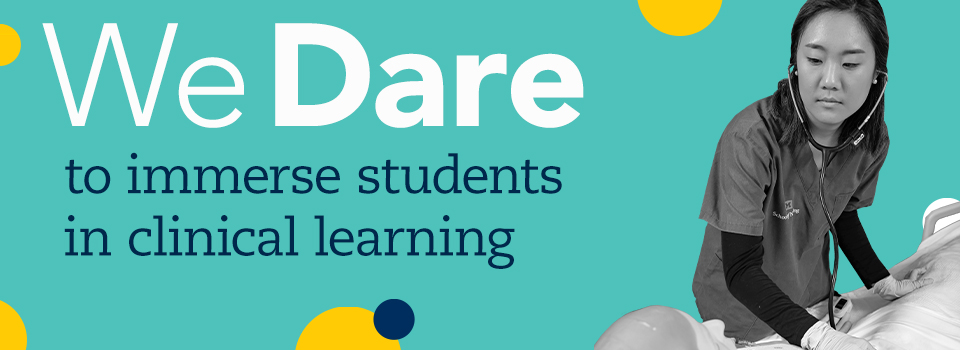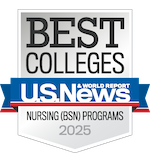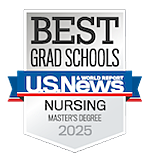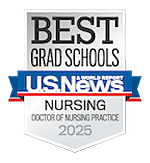We Dare to immerse students in clinical learning

How do you create a culture around clinical simulation?
In 2015, when the University of Michigan School of Nursing opened its new building at 426 N. Ingalls St., it also unveiled the state-of-the art Clinical Learning Center (CLC). The center would be a high-tech hub for clinical simulation, boasting advanced training technologies and skills labs that bring students directly into a real-world clinical setting.
The CLC was designed to help nursing students at every level hone their clinical skills in an environment that replicates what they will encounter in the field. It added a new dimension to nursing education at U-M, but the first few years served as valuable time to identify challenges and explore opportunities for growth.
In summer 2018, Clinical Assistant Professor Melissa Bathish, Ph.D., RN, CPNP-PC, and Clinical Instructor Deborah Lee, MSN, FNP, ACNP-BC, were appointed to lead undergraduate and graduate training at the CLC, respectively. They embarked on a shared mission to reevaluate CLC operations and optimize this important resource.
“In the first year or two, we weren’t really sure how to let students use the space,” said Bathish. “Faculty would send students to the CLC and head back to their offices. It was a rigid, high-stress environment more focused on testing.”
Bathish and Lee realized they needed a new clinical learning model led by faculty, moving away from embedded simulation educators and preparing faculty members to play a leading role in simulation education.
Through extensive evaluation and training, the CLC has become an integral part of the educational experience at the School of Nursing. Instructors are finding new ways to creatively engage with students by connecting classroom instruction to application in a clinical simulation.
“Faculty members are immersed in this simulation experience, problem-solving alongside their students, going through the debriefing process and having important conversations in a controlled environment,” Lee said.
“The CLC needs to be a playground where students aren’t afraid to make mistakes,” said Bathish, who is an expert on deliberate practice in nursing and the use of simulation technology in nursing education. “They have to learn to be comfortable being uncomfortable, and I think we’re establishing that.”
As the CLC team measures their progress, the data show a strong step in the right direction. From fall 2018 to fall 2019, the number of student visits to the CLC jumped from 297 to 1,184 — a staggering increase of 486%.
CLC experiences have been embedded in the graduate and undergraduate curricula. Practice hours are now required for many courses, and the CLC team has responded by opening up lab times in the evening to better accommodate nursing students’ busy schedules.
“How do you replicate what you do in the hospital and make it effective?” asked Lee, who also works on the Advanced Practice Team for Critical Care at Borgess Medical Center in Kalamazoo, Michigan. “That’s our focus, because that is how you create a stronger clinically trained nurse.
“I love the fact that I can take a case I just had in the hospital, implement it here and let students learn from that experience. I had a respiratory arrest and a cardiac arrest in clinic yesterday, and today I set up the same cases to see how students will handle it.”
Students encounter a range of scenarios in the CLC, from standard cases like sepsis to more complex crises like a misfiring implantable defibrillator. Undergraduate students follow a skills-based approach to learn the basics of patient care, while advanced practice graduate students take on more procedural training.
“Some students thrive in this environment because they are more hands-on and action oriented, while others are more reserved,” Bathish said. “But the more simulation students do and the more time they spend doing these procedures and activities, the more comfortable they become in this environment.”
Even with the success of the faculty-led approach, the CLC team is constantly looking for ways to improve the experience and increase opportunities for students and professionals at the School of Nursing and beyond. The center has hosted external conferences on issues such as chemotherapy safety and disaster preparedness. And throughout the year, more than 500 students from U-M schools and colleges including Medicine, Pharmacy, Social Work and Dentistry come to the CLC to conduct simulation exercises as part of an in-depth interprofessional education course.
Thoughtful evaluation has led to a dynamic shift at the CLC, where a more interconnected approach has helped the center become an essential educational resource for students and faculty alike.
“We want to create a culture that is safe, appropriate, healthy and welcoming to students and faculty, and our team has worked very hard to create that,” said Lee. “We’re excited to keep building for the future.”
“From fall 2018 to fall 2019, the number of student visits to the CLC jumped from 297 to 1,184 — a staggering increase of 486%.”
— Melissa Bathish, Ph.D., RN, CPNP-PC
Clinical Assistant Professor






